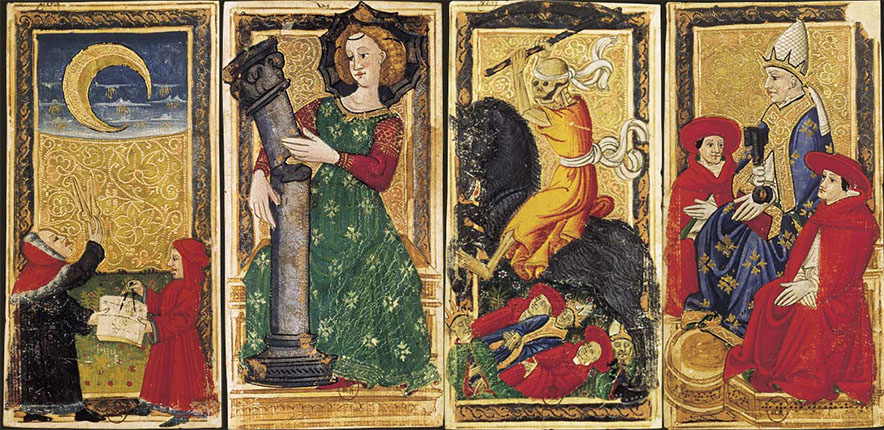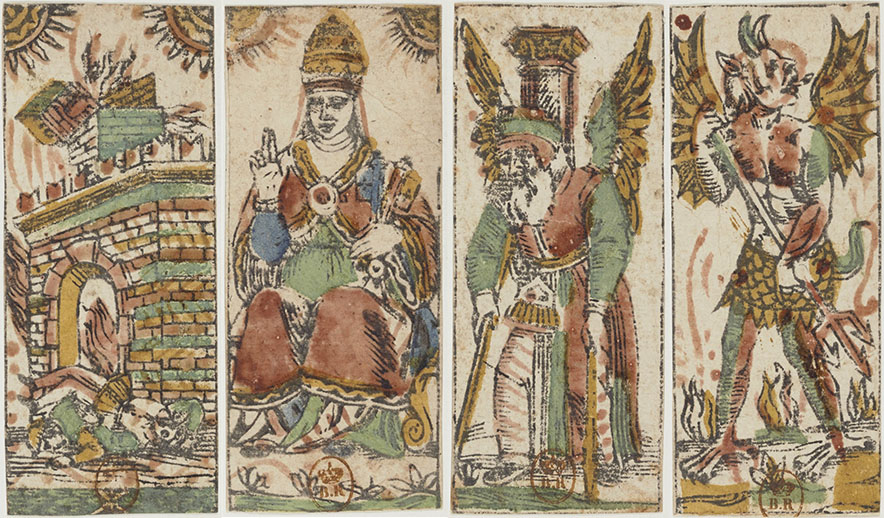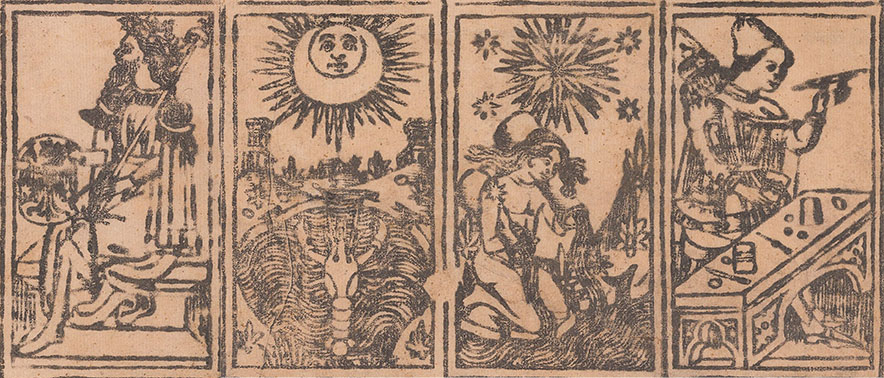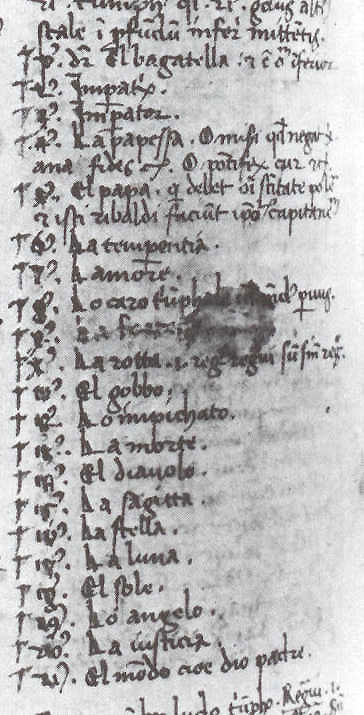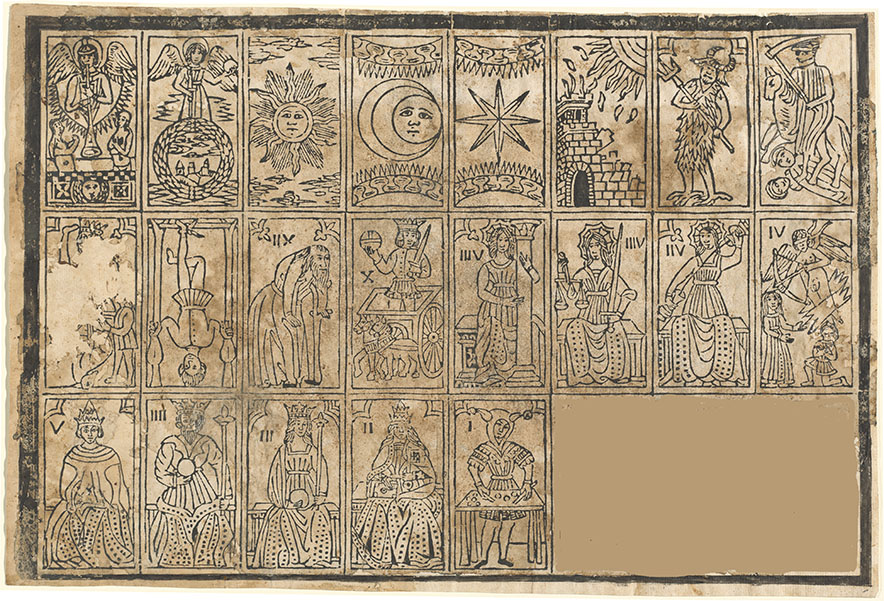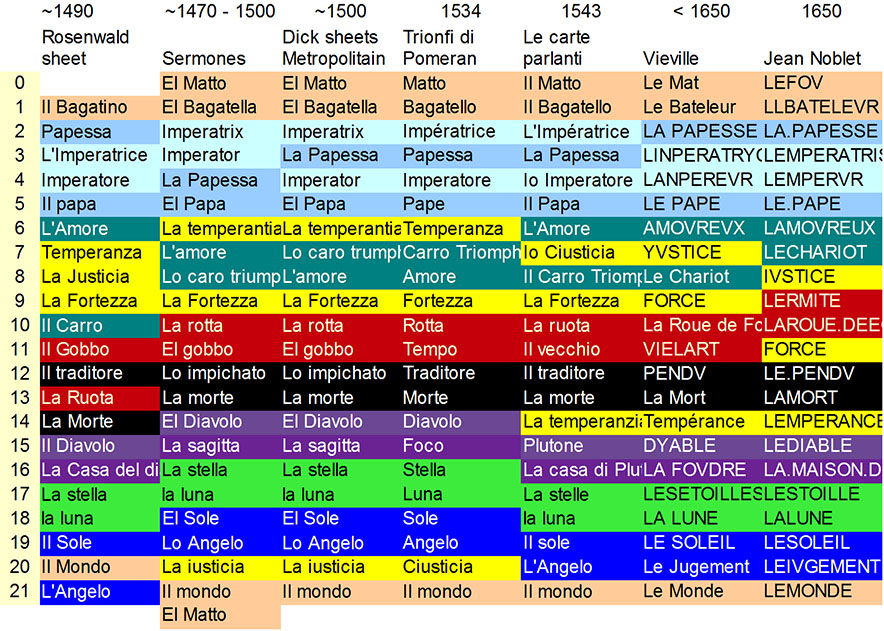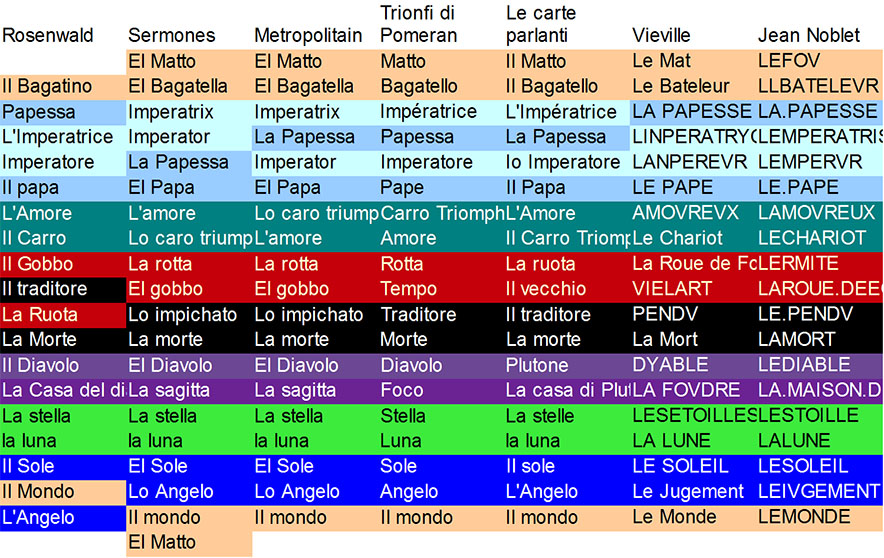THE TAROT WHEEL
THE TRUMP CARDS, NUMBERED OR ORDERED?
Many books have been written about the trump cards and their relation to the numbers. But, is this relationship so evident? Let us have a look at some of the oldest Tarot decks. First I’ll show you four cards of the so-called Charles VI deck, a deck that despite its name originates from Northern Italy, probably Florence, commissioned by the Este court of Ferrara, and that is dated to the third quarter of the 15th Century.
Beautiful cards made by a very skilled artist. We can recognize from left to right the Moon, Force, Death and the Pope. But where are the names on the cards, and even more important, where are the numbers? What is their order? Let us have a look at another deck, the Tarocco di Bologna, dated to around 1600.
Here we see respectively the Tower, the Popess, Time (or the Old Man) and the Devil. Again, there are no names and no numbers at all. How can we know the order of these cards?
Also, the uncut sheets, found in the interior of old books, do not always give us a hint to the numbering. As an example, I show you some cards of the so-called Cary sheet, dated to around 1500. Like the other cards presented here, they have their origin in Northern Italy, this time probably from Milan.
We see from left to right the Emperor, the Moon, the Star and the Conjurer (the Juggler or the Magician) Again there are no names and no numbers. This gives us a problem. We are dealing here with playing cards, every card has a different value, how to know this value?
I suppose for the regular player, this was not a big deal. Any card player manipulated the cards very often, and they would know the name and value of every distinct card. So if everybody played with the same rules, the numbering of the cards was evident. Or wasn’t it? Above we see cards from three different cities. There were apparently regional differences in the value of the cards during a game. Ferrara, Bologna and Milan used their own system.
The oldest indication about the numbering of the Tarot Trumps we have, is from a probably Franciscan Monk, who put this text on paper somewhere between 1470 and 1500 in the Ferrara region. The text is called the Sermones de Ludo Cum Aliis or also the Steels Sermon.
According to the sermon, all games played with money, especially dice, card games and trumps, are invented by the Devil to keep the people outside the Church. The worst is the game of thumps, the 21 trumps are the 21 steps on the ladder that take the people down into hell. According to the script, the 21 steps are as follows:
1. El Bagatella (the Street Performer)
2. Imperatrix (the Empress)
3. Imperatori (the Emperor)
4. La Papessa (the Papess)
5. El Papa (the Pope)
6. El Temperantia (Temperance)
7. L'Amore (Love)
8. Lo Caro Triumfale (the Chariot of Triumph)
9. La Fortezza (Strength)
10. La Rotta (the Journey)
11. El Gobbo (the Hunchback)
12. Lo Impichato (the Hanged Man)
13. La Morte (Death)
14. El Diavolo (the Devil)
15. La Sagitta (the Arrow of Light)
16. La Stella (the Star)
17. La Luna (the Moon)
18. El Sole (the Sun)
19. Lo Angelo (the Angel)
20. La Justicia (Justice)
21. Il Mondo (the Universe)
El Matto (the Fool) is mentioned after the trumps. According to the text, if you want to attribute a number to this card, it should be 0.
Still, it was not easy for card playing. On the Italian courts there was no problem, people were highly educated, and they could easily remember the reason why one card was higher than another. For the common people, this was different. Lot of people did not have the slightest education, and for them, the order of the cards was not evident. As a consequence, somewhere in the fifteenth century, people started to write themselves the numbers on the card. Certainly mistakes were made, there was a real need to have the numbers printed on the cards. Let us look at the following example, the Rosenwald sheet.
In the Rosenwald sheet, the Fool is missing, although the first card has the characteristics of both the Fool and the Conjurer (the Magician). Three cards that are not part of the trumps are hidden in the figure here above. Numbering is consistent until VIII, although all numbers are mirrored. The 9th card is also numbered VIII and the eleventh card is numbered XII. After making all these errors, the card maker probably stops numbering the cards and discarded the sheet. This is a hint that the original woodblocks were not numbered, and that the numbers were added after printing the cards. There is a second sheet available in the Leinfelden museum in Germany, heavily damaged, but it appears that numbering is not exactly the same.
If the order of the cards on the sheet is effectively the order of the trumps, then this does not correspond with the order as we have seen in the Sermones. As stated earlier, there were regional differences and every city had its own rules to play the game of trumps. Let us compare some of the information that we have from written sources, uncut sheets and card decks from the 15th to the 17th century:
As You can see, the first six cards are always the same, with the Magician always number one and the Pope always on the fifth place. The Popess can be on any place in between these two cards. The hanged man has always the number 12 (at least in the examples above) and is followed by Death with number 13 except for the Rosenwald sheet where this card actually isn't numbered. In the first column you see the Rosenwald sheet as example for the Southern group (Bologna), the next three columns are representative for the Eastern group (Ferrara) and the last three columns are representative for the Western group (Milano). It is clear that the big difference between these groups is the location of the Virtues. From this variety in numbers and places, we conclude that the Virtues probably where a late addition to the decks, something that supports the possible original structure with 5 suits of 14 cards. Note also the place of Fortitude and the Hermit in the Vievil game. Many scholars have stated that the cards of Vievil were inversely printed, and that for this reason the cards IX and XI, the Hermit and Fortitude shifted places when compared to the Tarot of Marseille. But this is a modern point of view, when looking at older sources, Vievil is consistent with Italian tradition, and it is the Tarot of Marseille (Jean Noblet) that used another pattern for reasons that will be explained later.
When we remove the three Virtues from the decks, and look only at the order of the other trumps, the different versions of the Tarot become almost identical:
As we saw on the first table, the Popess is moving within the second and third pair, there are some minor differences in the southern group and there is some disagreement about the order within some other pairs. Except for these minor points, there are no differences in the order of the trumps between the several versions of the early Tarot.
My conclusion is obvious; there is no direct link between a specific trump card and a certain number. On the Tarot of Marseille there might be, but looking to all tarot games ever made before the Tarot of Marseille, there is no link at all. Because of the many regional differences, card makers started to number the trump cards with as only reason to indicate the order that should be used for their specific version of the Tarot Game. As a consequence, the trump cards are not numbered, they are ordered. If a number is shown on a trump card, this serves only as a visual help for card players in a game to determine which card is higher. So forget all those tens of thousands of pages that has been written about Tarot numerology, originally, a trump card does not correspond to a specific number, the trump cards are ordered
